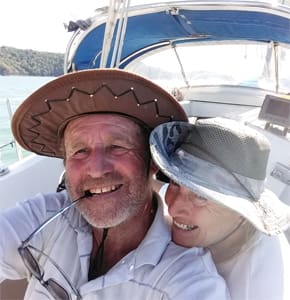Australian voyagers Mike and Gay Lewis are longtime live-aboards who built their own boat and have sailed extensively, including having passed all of the five Southern Ocean great capes. They started their voyaging career by building their 36.5-foot ferrocement boat Expeditus in their backyard. The building program of nights and weekends took the couple four years and nine months before the boat was launched in December 1977.
From 2005 to 2008, the Lewis’ did a major refit of Expeditus that included a new engine, rigging, cabin top, cockpit, new paint, sails, solar panel and more.
In a series of multiyear stints, they sailed in the North Sea, the North and South Atlantic, the Pacific and the Indian Ocean, including the U.K., Cape Horn, the Falklands, the Canaries, the Caribbean, the Bahamas, the U.S., the Azores, Madeira, Gambia, Brazil, Cape Town, Fiji, Vanuatu, New Caledonia, the Philippines, Indonesia, Brunei, Borneo, peninsular Malaysia and Thailand. They are presently in Langkawi, Malaysia.
OV: How do you approach the subject of safety? Has your experience sailing offshore affected your thinking on safety?
M&GL: To us, safety has two major components: keeping your boat off the rocks, and keeping yourself on the boat.
Keeping your boat in its element instead of on the rocks requires many things — planning sheltered anchorages, allowing for wind shifts, squalls or unexpected gales, avoiding rocks and reefs, having adequate ground tackle, having a “let’s get out of here” plan, and much more.
We use a 90-pound fisherman/Admiralty anchor on our 36-foot yacht, and dragging anchor is an exceptionally rare event for us. Laying down a track on a chartplotter upon entering an anchorage can be a big help in getting out safely, if required, on a dark and stormy night. Having redundancy in electronic charts and devices, and not relying on electronic charts to be accurate or show all details is also critical.
 |
|
Expeditus at Constitution Dock, Hobart, Tasmania. |
|
Mike Lewis |
Being able to spring off a dock against a side wind and waves is also an important thing to learn, but it is better to not get pinned there in the first place.
On our offshore voyages, we are often amazed at how quickly a ship can appear from over the horizon, and this is the one thing most constantly on our minds.
At sea, apart from having a strongly built and rigged boat, it is obviously all about ensuring that you never fall overboard. We have lost more than half a dozen yachtie friends who have had this misfortune.
On our home-built yacht, we installed higher-than-normal stanchions (30 inches), through-bolted, with backing plates. The stanchions are closer together than many boats and have double safety lines, although today we would use triple.
Strong jack lines are secured to our stern bollards and staysail deck fitting. Beware of UV damage and aging of webbing strops.
We have short jack lines in the cockpit that are through-bolted with U-bolts and large backing plates to take the load. Our safety harness lanyards have fittings to current standards now, compared to our original gear that we made ourselves in 1977 from seatbelt webbing, stainless-steel ring loops, three-strand rope lanyards, and an eye spliced to a standard carabiner hook!
Situational awareness when on deck is critical, as well as below. The ability to be able to judge how your vessel will pitch or roll in response to a particular wave is important for retaining your balance. Plenty of adequate handholds above and below decks, and the ability to hook onto jackstraps before exiting the hatch are essential.
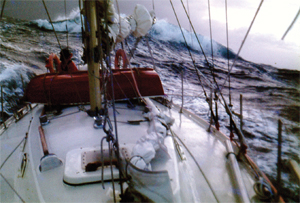 |
|
A large breaking wave west of Cape Horn, January 1980. Expeditus carries only a reefed storm jib. |
|
Mike Lewis |
We are inclined to think that when it is exceptionally rough and dangerous that you tend to be exceptionally cautious, only going out on deck if necessary, very well secured to the boat and watching every wave. However, we think that there is another very dangerous set of conditions: when going downwind and it is only “a little bit rough” or “a bit breezy” — not enough to raise any sense of alarm for the safety of the vessel itself, but potentially deadly if you happen to fall overboard in those conditions. Should that happen, the crew would be short-handed to deal with getting the boat turned back into an apparent wind that is now blowing 12 knots or more.
We consider that lee sheets on bunks are important, although we did sail around the world without them in the Southern Ocean with only a pillow or two stuffed under the mattress to tilt it, or sleeping on the sole when very rough. But I would recommend complete bunk tie-downs, too, for Southern Ocean sailing. On a more recent trip, I was sent over the top of our berth lee sheets onto the cabin ceiling! But this was near the Kermadec Trench where deep water meets shallow and currents affect the waves.
There are other aspects to safety, and as we age we are very aware of the trouble a broken hip, arm or leg could bring at sea. We move with care, and we have taken our non-skid paint to the very edge of all corners instead of leaving a pretty (and slippery) margin of paint around the edges. We cook with care, and we never pour boiling water athwartships — always facing forward.
While there is always more we could do in the area of safety, we have managed adequately over the last 42 years. A broken wrist from the manual anchor winch handle kicking back when a pawl did not engage has been our only misfortune.
OV: What planning do you do for a possible medical emergency? Did you receive any medical training before you began voyaging?
M&GL: As voyaging sailors, you have to be multiskilled over a diverse range of talents — you are the ship’s captain, navigator, cook, plumber, electrician, carpenter, painter, diesel mechanic, rigger, sailmaker, meteorologist, lawyer and doctor — just to name a few!
We were fortunate to some extent in that my brother was a doctor and we were able to squeeze some knowledge out of him in addition to The Ship Captain’s Medical Guide, Advanced First Aid Afloat and other publications. We undertook a first-aid course prior to launching in 1977 but have not done any refresher courses since. We have continued to improve our medical knowledge over the years, however, via discussions with sailing nurses and doctors that we meet, as well as GPs that we have occasion to visit on land. We exercise appropriate medical caution on land, give wide berth to people sneezing or coughing, and do not eat out in places that do not have running water.
We have always considered it unlikely that we would come down with some exotic illness or injury at sea, given the amount of time we spend at anchor, in marinas and on coastal passages compared to being in the middle of the ocean. Even on our longest ocean voyage of 84 days from the Falklands to the U.K., we were often only a week or 10 days away from land for much of that journey, and considered that something like appendicitis could be kept subdued by antibiotics until help was reached.
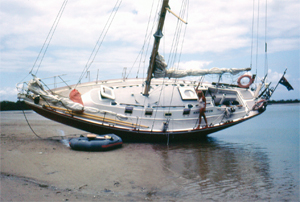 |
|
Careening Expeditus in Salvador, Brazil, 1986. |
|
Mike Lewis |
OV: What type of life raft do you have?
M&GL: It is exceptionally rare for us to have more than just ourselves on board Expeditus, so for just two people we use a four-man life raft.
It is a Zodiac Open Sea model, purchased through MarineSafe Australia. It is in a fiberglass canister, and we keep it belowdecks out of the weather. In a perfect world, and with a larger boat, we would have a dedicated life raft locker in the cockpit area.
OV: What do you have in your abandon-ship bag?
M&GL: Our primary grab bag is a plastic drum with a large-diameter rubber lid.
The drum has a rope and snap shackle attached so that it can easily be clipped onto the ship’s rail, life raft, life harness, etc. This advice came to us from friends who had to make the decision to drop their grab bag to get hold of one of their children. The grab bag washed away!
Our drum contains: food, three solar water stills, fishing gear, flares, EPIRB and PLB, gloves, knife, repair kit, superglue, sunglasses, zinc cream, torch and batteries, laser pointer, copies of ship’s papers and passports.
At sea, we also have additional containers for water and food, also with lanyards attached. An additional VHF and satphone already packed up would be a good addition.
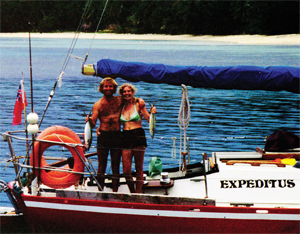 |
|
Mike and Gay with a fresh catch at the Blue Lagoon in the Yasawa Group, Fiji, 1979. |
|
Mike Lewis |
OV: Do you have survival suits with you?
M&GL: No, we do not. For a trip to the Arctic, Antarctica or in the Southern Ocean we would certainly get kitted up with survival suits. They have proven themselves invaluable when disaster has befallen yachts in these seas.
OV: Do you have an EPIRB, PLB or a tracking/messaging device like an inReach or SPOT?
M&GL: We have two EPIRBs on board (one with a just-out-of-date battery) as well as one PLB.
We do not have any tracking device but have on rare occasions used an Iridium satphone to text our current position, speed and heading to a family member.
Having cut our sailing teeth in the era of sextant navigation, pre-Internet, and without a long-range radio, it has never bothered us to be incommunicado for extended periods on ocean crossings, but the EPIRBs and satphone are there if ever needed.
OV: Do you actively use radar for collision avoidance?
M&GL: No, we have never had radar on our yacht.
When we first launched in 1977, we were young and somewhat constrained by money, a suitable space for the display and the heavy electrical consumption of radar in those days.
With modern technology and less power consumption, I think we would choose to get radar for any new boat build, as well as a radar alert system.
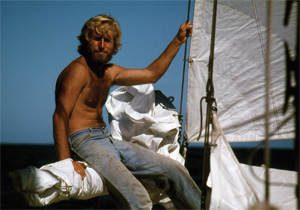 |
|
Mike while underway in the Tasman Sea, en route from Brisbane to New Zealand, 1979. |
|
Gay Lewis |
OV: Do you have an AIS unit on board?
M&GL: Yes, we have a stand-alone Vesper AIS with display screen. It has been invaluable in picking up ships on a collision course in remote areas where one is not expecting to see much traffic. So, a very valuable tool, especially for short-handed sailors on the open sea. It gives great peace of mind for very little power consumption.
AIS is becoming compulsory to have and use in many countries now. We do not see it as being so essential on coastal passages where one, of necessity, has to keep a much more thorough lookout anyway for nets, pots, canoes, etc., and vessels without AIS. But on the open ocean, it is an invaluable tool to have.
OV: What types of weather data do you use on your voyage? How do you gather weather information?
M&GL: We started sailing in 1977 with sextant, compass, mechanical log and barometer. We had no HF or VHF radio, so weather reports as such were very thin on the ground, only what we could get on our multiband receiver. We rather flippantly used to say that we got two weather reports each year, one called summer and one called winter!
By using pilot charts, we at least had some idea of prevailing winds, currents, percent gales and calms, and after that we took whatever came our way. We used the expected winds of low- and high-pressure systems to plan our departures to at least get a good start to our ocean passages. If we had a big gale a few days before landfall, we were comforted that the risk of another gale at landfall was therefore somewhat reduced!
With a lot of coastal passages nowadays in the Asian region, we tend to use mobile phone data to access weather through Predict-Wind or Windyty. Also, shore-based radar stations are useful indicators for a short-term view of cloud/squall activity.
For ocean passages, we still live in the dark ages and take what comes our way. Our basic premise is to sail high latitudes (westerlies/Roaring Forties) in summer and lower latitudes (tropics/trade winds) in winter, avoiding the tropics in summer (cyclone) season.
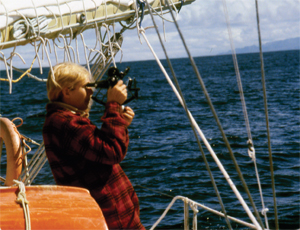 |
|
Gay taking a sextant sight while sailing from Brazil to Cape Town, 1986. |
|
Mike Lewis |
On a recent trip from Langkawi to Perth during the cyclone season on a friend’s boat, shore-based sailing friends would message to a satellite phone with updates of low-pressure systems and tropical storm formation and headings.
We acknowledge that access to wind and current data at sea can be very beneficial, and intend to look at systems such as Iridium GO in the future.
OV: What are your future voyaging plans?
M&GL: Our next voyage is likely to be on a rally down the west coast of Sumatra, through to southern Borneo, then the Anambas Islands and Natuna, all within Indonesia. This will only be our second rally, but we see some advantage in securing easy visa extensions as well as significant cultural experiences woven into the event.
Subsequently, we would like to cross the southern Indian Ocean via Mauritius and Madagascar to South Africa, and eventually complete our second circumnavigation via Brazil, Caribbean and the Pacific Ocean.

